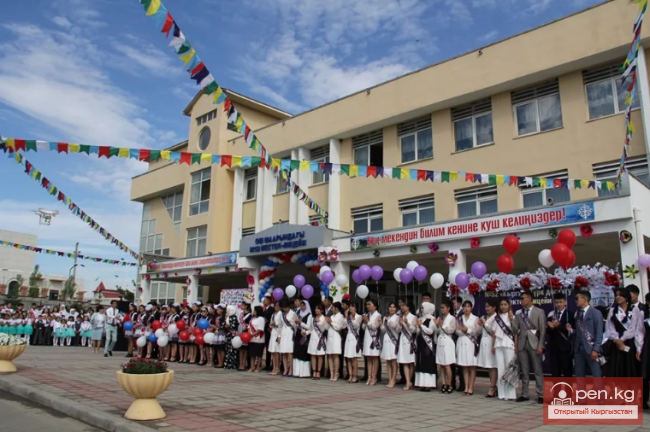
Before the revolution, there were 107 Russian schools in Kyrgyzstan, where, in addition to Russian...

The First Enlighteners: Ishenaly Arabayev, Ibraim Abdyrahmanov After Kyrgyzstan joined Russia,...

Arabay Uulu Eshenaly (Arabayev Ishenaly) (1882-1938) - a representative of science and culture at...

Over the past 15 years, the system of general secondary education has functioned quite steadily,...

Primary Education in the City of Osh The city of Osh is not only a hub of industry but also a...

Students of the International University "Atatürk-Alatoo" have published a manual titled...

The establishment of printing and book publishing in the republic was fraught with great...

The structure of education in Kyrgyzstan encompasses eight official levels, approved by the Law of...

In the photo: Second graders of the "Olymp" primary school in Osh during a Russian...

The First Republican Competition of Young Readers among Children and Youth of Kyrgyzstan "The...

It is known that in the 18th century, the Kyrgyz, although rarely, used a new writing system, as...

The emergence of periodical press in Kyrgyzstan dates back to 1913, when representatives of the...

Printing in Kyrgyzstan On November 7, 1924, the first issue of the newspaper "Erkin-Too"...
In Kyrgyzstan, the implementation of the program to provide schools with new textbooks, prepared by...

The foundation of Kyrgyz written literature was the rich oral folk creativity. Therefore, it is...

By September 1, 23 schools will be completed in Kyrgyzstan, as reported by the Minister of...

1960-1966. Academy of Sciences of the Kyrgyz SSR Certain successes were achieved in science. In...

With the victory of the October Socialist Revolution of 1917 in Russia and its outskirts,...
The event "International Cooperation in the Field of Distance Education" took place on...

Poet and linguist K. Tynystanov was born on September 9, 1901—November 6, 1938, in the village of...

At the beginning of 1925, together with the governing bodies of the Kyrgyz Autonomous Region, the...
During the meeting held on October 22 between Ambassador Nicolas Fay and Minister of Education...

At the beginning of the 2004/05 academic year, the number of teaching staff in secondary...

In the photo: Students and teachers from Gymnasium No. 1 in Chui region and School No. 52 in the...

Tynystanov Kasym (1901-1938) - linguist, poet, playwright, public figure, professor (1936)....

“I AM A COMMUNIST!..”...

Prose writer M. Imazov was born on May 1, 1941, in the village of Aleksandrovka, Moscow District,...

Technical Schools of Osh The city is home to a number of specialized secondary educational...

Baytur Anvar (1938-1991), a prominent scholar and historian of modern Kyrgyz people. He was born...

Since 1998, the reduction in the number of preschool institutions has been halted, and a...

Arabaev Erikin Ishenalievich (1924-1994), Candidate of Economic Sciences (1956), Professor (1968)...

The Tsar is Overthrown. The life of the people did not improve. In early 1917, the news spread...

A Kyrgyz delegation headed by the Minister of Education and Science of the Kyrgyz Republic K....

National Policy of Soviet Power Among the main points of the Bolshevik party program, led by V. I....

Dzhusaev Dzholdosh (1934-2001), Doctor of Philological Sciences (2000), Professor (1993). Kyrgyz....

As part of the implementation of the tasks defined by the Education Development Strategy of the...

Today, October 24, 2014, the President of the Kyrgyz Republic, Almazbek Atambaev, sent a...

35 schools in Kyrgyzstan located in hard-to-reach mountainous areas are awaiting the OneWeb social...

Kyrgyz citizens are once again complaining about problems in the education system. Rising tuition...

Prose writer O. Aitimbetov was born in the village of Sary-Kamysh in the Issyk-Kul district of the...

Kyrgyz in Uzbekistan Beyond Kyrgyzstan, Kyrgyz people have long lived in China and Uzbekistan,...

The Kyrgyz are one of the oldest peoples who lived in Central Asia and roamed the vast expanses of...

The poet Y. Shivaza was born on May 18, 1906, and passed away on June 18, 1988, in the village of...

Today, the Prime Minister of the Kyrgyz Republic, Joomart Otorbaev, participated in a ceremonial...
The Department of Education of the Bishkek City Hall commented on the situation related to video...

Poet T. Adashbaev was born in the village of Mazar in the Ala-Buka district of the Osh region into...

Madrasah for children, built by Shabdan Jantayev in 1907 - 1909. Hero, Demanded by the Era. Part...

Establishment of Autocracy. The Soviet power had many enemies—both external and internal. They...